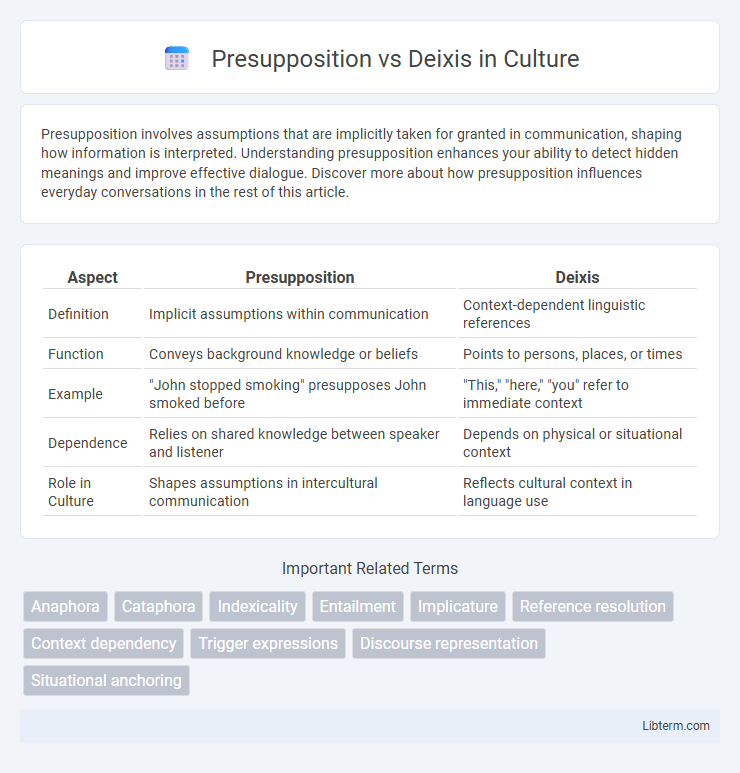Presupposition involves assumptions that are implicitly taken for granted in communication, shaping how information is interpreted. Understanding presupposition enhances your ability to detect hidden meanings and improve effective dialogue. Discover more about how presupposition influences everyday conversations in the rest of this article.
Table of Comparison
| Aspect | Presupposition | Deixis |
|---|---|---|
| Definition | Implicit assumptions within communication | Context-dependent linguistic references |
| Function | Conveys background knowledge or beliefs | Points to persons, places, or times |
| Example | "John stopped smoking" presupposes John smoked before | "This," "here," "you" refer to immediate context |
| Dependence | Relies on shared knowledge between speaker and listener | Depends on physical or situational context |
| Role in Culture | Shapes assumptions in intercultural communication | Reflects cultural context in language use |
Introduction to Presupposition and Deixis
Presupposition involves implicit assumptions that must be true for a sentence to make sense, such as "John's brother is tall" presupposing John has a brother. Deixis refers to words and phrases like "this," "that," "here," and "now," which require contextual information to clarify their meaning. Understanding presupposition and deixis is essential for interpreting meaning and reference in natural language communication.
Defining Presupposition: Meaning and Examples
Presupposition refers to the implicit assumptions or background beliefs that must be accepted as true for a statement to make sense, such as "The king of France is bald," which presupposes there is a king of France. It differs from deixis, which involves context-dependent expressions like "this," "that," or "here" that rely on the speaker's time, place, or situation for interpretation. Understanding presupposition is essential in linguistics and pragmatics for analyzing how meaning is conveyed beyond the literal content of sentences.
Defining Deixis: Meaning and Examples
Deixis refers to words and phrases, such as "this," "that," "here," and "now," whose meanings depend on the context of the utterance, specifically the speaker's location, time, and identity. These deictic expressions require contextual information to be properly interpreted, distinguishing them from other linguistic elements that have fixed meanings. Examples include spatial deixis ("Put the book here"), temporal deixis ("I will go tomorrow"), and personal deixis ("She is coming with me").
Key Differences Between Presupposition and Deixis
Presupposition involves implicit assumptions within a sentence that must be true for the sentence to make sense, such as "The king of France is bald" presupposing that a king of France exists. Deixis refers to words or phrases, like "here," "now," or "you," that require contextual information to determine their meaning based on the speaker's location, time, or identity. Key differences lie in their functions: presupposition relates to background assumptions embedded in utterances, while deixis concerns the shifting reference of expressions dependent on the speaker's context.
Types of Presupposition in Linguistics
Presupposition in linguistics involves background assumptions required for an utterance to make sense, including types like existential (assuming the existence of an entity), factive (assuming truth of a proposition), lexical (inherent in word meanings), structural (triggered by sentence structure), and non-factive presuppositions (not necessarily true). Deixis, by contrast, refers to words and phrases, such as "this," "that," or "here," that require contextual information to be interpreted. Understanding these presupposition types aids in analyzing how speakers convey implicit information beyond literal meaning.
Types of Deixis in Linguistics
Deixis in linguistics is categorized into several types, including person deixis, which refers to the participants in the discourse such as "I," "you," and "they"; place deixis, indicating spatial locations like "here," "there," and "over there"; and time deixis, relating to temporal points such as "now," "then," and "soon." Other types include discourse deixis, which points to segments of the conversation or text itself, and social deixis, involving social relationships and relative social statuses expressed through language. These categories are crucial for understanding the context-dependent nature of deixis, distinguishing it from presupposition, which involves implicit assumptions within utterances.
Role of Context in Presupposition and Deixis
Presupposition relies on shared background knowledge and assumptions inherent in the speaker's and listener's common context, making the interpretation stable across different utterances. Deixis depends on the immediate situational context, including time, place, and the participants in the conversation, to anchor the meaning of expressions like "this," "that," "here," and "now." Both presupposition and deixis require contextual information, but presupposition invokes implicit information assumed to be known, while deixis directly points to elements within the current speech situation.
Presupposition Triggers and Deictic Expressions
Presupposition triggers are linguistic elements such as definite descriptions, factive verbs, and cleft sentences that imply the existence of certain information within a discourse, ensuring shared knowledge between speaker and listener. Deictic expressions, including demonstratives like "this" and "that," personal pronouns, and temporal adverbs, rely on contextual cues such as time, place, and participant roles to convey meaning. Understanding the interaction between presupposition triggers and deictic expressions is essential in pragmatics, as it distinguishes background assumptions from context-dependent references in communication.
Challenges in Analyzing Presupposition vs Deixis
Analyzing presupposition versus deixis poses challenges due to their overlapping reliance on context for meaning interpretation, where presupposition involves assumed background knowledge and deixis requires identifying referents relative to the speaker's location and time. Disentangling these requires precise contextual anchoring and distinguishing between stable presupposed information and shifting deictic references like pronouns or temporal expressions. Computational models further struggle to reliably resolve presuppositions without conflating them with deixis, complicating natural language understanding and processing tasks.
Conclusion: Importance in Pragmatics and Discourse Analysis
Presupposition and deixis are essential concepts in pragmatics and discourse analysis because they reveal how meaning depends on context and shared knowledge between speakers and listeners. Presupposition enables speakers to convey implicit assumptions that background understanding relies on, while deixis anchors utterances in the spatial, temporal, or personal context of communication. Mastery of these phenomena enhances interpretation accuracy and facilitates effective interaction in natural language.
Presupposition Infographic

 libterm.com
libterm.com